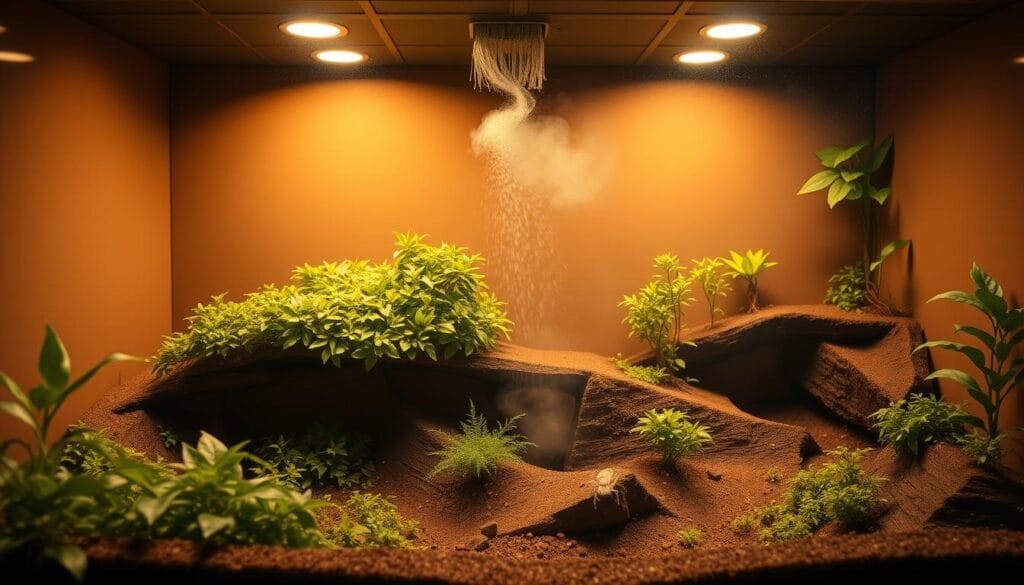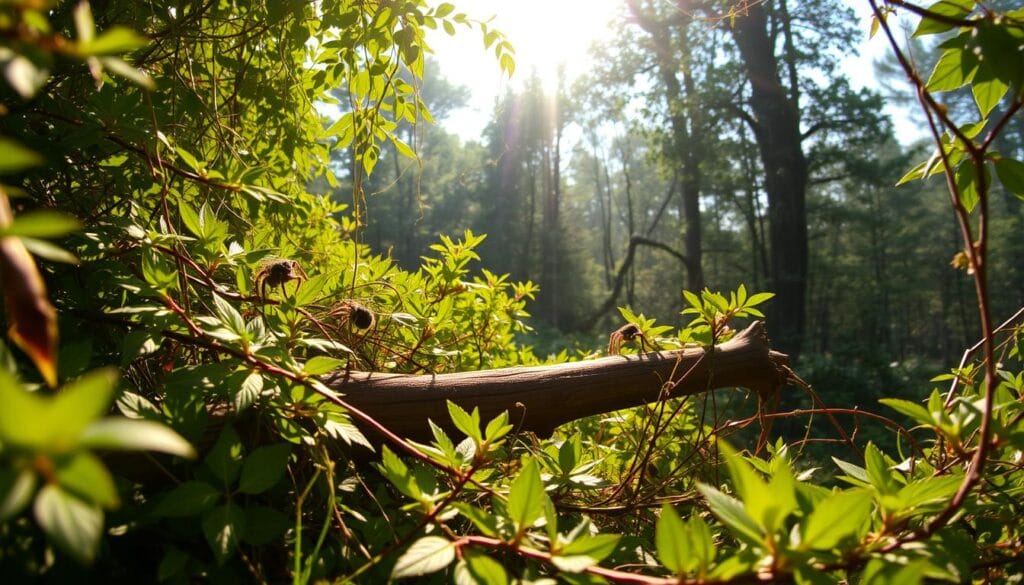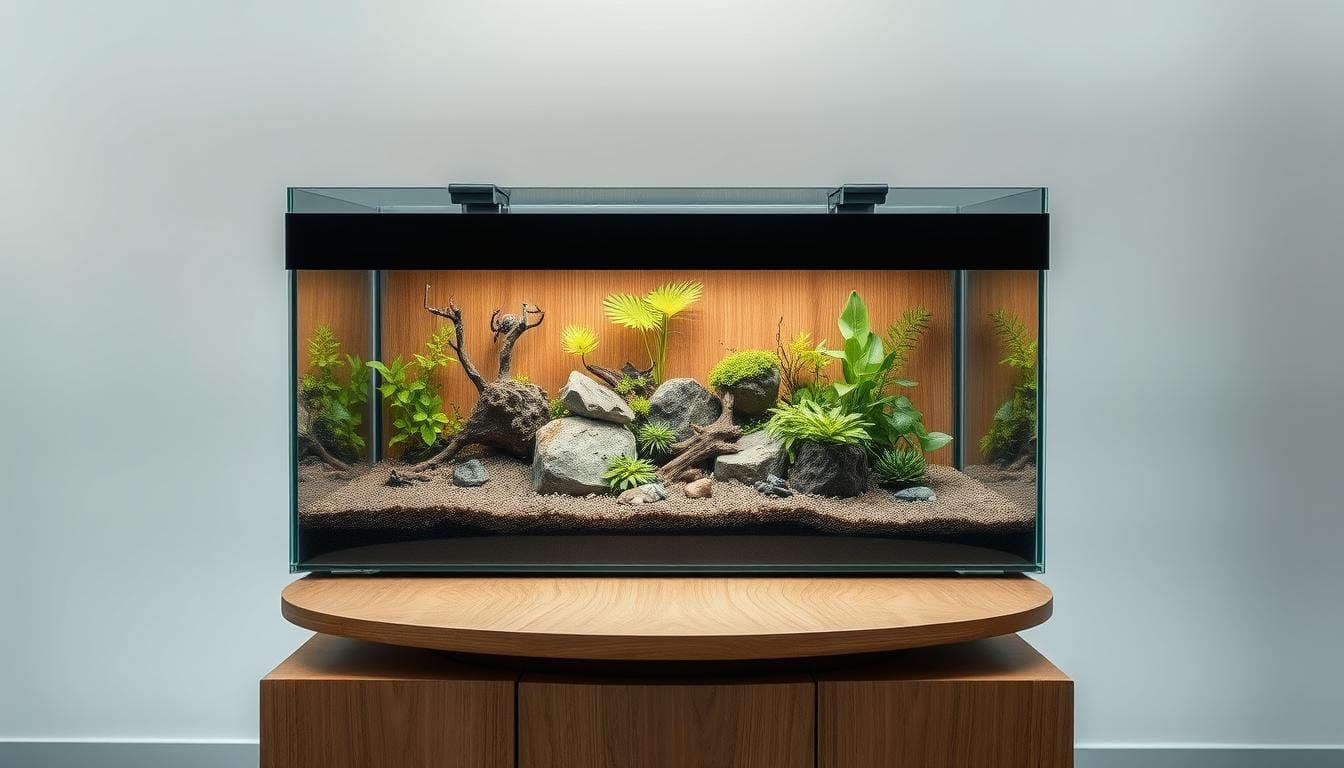Creating a comfortable and safe environment for your pet is crucial. If you own a jumping spider, you know how vital the right enclosure is. It ensures their well-being and happiness.
A top-rated spider enclosure can greatly impact your pet’s health and activity. With many options in 2025, finding the best one can be tough.
When picking an enclosure, several important factors matter. These include ventilation, visibility, and ease of cleaning. In this article, we’ll dive into these factors and show you some top choices.
Table of Contents
Importance of Choosing the Right Enclosure for Jumping Spiders
A good enclosure is key for your jumping spider’s health and happiness. It needs to have the right air, temperature, and space for climbing.
Benefits of a Suitable Enclosure
A good enclosure has many benefits. It makes sure your spider gets proper ventilation. This keeps the air fresh and prevents moisture buildup. It also helps control the temperature to keep your spider comfortable.
Here are some key benefits of a well-chosen enclosure:
- Enhanced ventilation
- Better temperature control
- Ample space for climbing and hunting
- Reduced stress through environmental enrichment
| Feature | Importance | Benefit |
|---|---|---|
| Proper Ventilation | High | Prevents moisture buildup and maintains air quality |
| Temperature Control | High | Ensures optimal temperature for spider’s health |
| Space for Climbing | Medium | Encourages natural behavior and exercise |
Effects on Spider Behavior
The enclosure you choose affects your spider’s behavior. A big enclosure with climbing spots helps your spider hunt and move around. This reduces stress and keeps your spider happy. But, a bad enclosure can stress your spider and cause odd behaviors.
Knowing how a good enclosure affects your spider’s behavior helps you choose the right one. This improves your spider’s life and makes caring for it more fun.
Types of Jumping Spider Enclosures Available
Finding the right enclosure is key for your jumping spider’s health and happiness. There are many types to pick from. You need to think about visibility, ventilation, and what your spider needs.
Glass Terrariums
Glass terrariums are a favorite for jumping spiders. They offer excellent visibility and can look great in any room. A glass terrarium can be a beautiful Spider Terrarium, letting you see your spider’s life up close.
One big plus of glass terrariums is they keep humidity and temperature right. But, they can be heavy and might need extra light. This is something to think about when setting up your Spider Tank.
Plastic Containers
Plastic containers are another good choice for jumping spiders. They are more affordable and lightweight, making them easy to move. But, they might not let you see as much as glass terrariums.
It’s key to make sure plastic containers have good ventilation. This stops moisture from building up, which can cause mold and other problems.
Custom-Built Enclosures
Custom-built enclosures are great for those who want a special home for their spider. These can be made to fit your spider’s exact needs. This includes specialized ventilation systems and unique substrate options.
| Enclosure Type | Visibility | Ventilation | Customization |
|---|---|---|---|
| Glass Terrariums | Excellent | Good, with proper setup | Limited |
| Plastic Containers | Fair | Variable, depends on setup | Limited |
| Custom-Built Enclosures | Variable, depends on design | Excellent, can be tailored | Highly Customizable |
Knowing about the different enclosures helps you choose the best one for your jumping spider. This ensures they are happy and healthy in their Spider Terrarium or Spider Tank.
Size Recommendations for Jumping Spider Enclosures
A good-sized enclosure is key for your jumping spider’s health and happiness. The enclosure’s size affects your spider’s movement, climbing, and overall well-being.
Ideal Dimensions
The right size for a jumping spider enclosure depends on the species. A general guideline is to offer a roomy space for climbing. For most jumping spiders, an enclosure that’s twice as tall as the spider’s leg span is best.
For instance, if your spider’s leg span is about 2 inches, aim for an enclosure that’s at least 4 inches tall. Also, make sure there’s enough floor space for your spider to move around. A minimum size of 5-10 gallons is often recommended for adult jumping spiders.
Space for Climbing
Jumping spiders love to climb and are very agile. So, it’s important to have enough vertical space in the enclosure. Adding branches, rocks, or plants can make the environment more interesting and encourage natural behavior.
“Jumping spiders are intelligent and curious arachnids that require a lot of stimulation and space to climb and roam.” – Learn more about the fascinating world of jumping spiders on Exotic Pet Haven.
When setting up the enclosure, think about your spider’s need for climbing spots and horizontal space. A well-designed enclosure will keep your spider happy and give you a great view of its natural behaviors.
- Ensure the enclosure is secure to prevent escape.
- Provide a substrate that retains humidity but also allows for drainage.
- Incorporate decorations that mimic the spider’s natural habitat.
By focusing on the size and design of the enclosure, you can create a Best Spider Enclosure for Jumping Spiders that meets your pet’s needs and improves its life quality.
Materials to Consider for Enclosures
The material of your jumping spider’s enclosure is key to a healthy home. It’s important to weigh the good and bad of each option.
Glass vs. Acrylic
Glass and acrylic are top picks for jumping spider homes. Glass is tough, easy to clean, and lets you see everything. But, it’s heavy and can break if dropped.
Acrylic is lighter and safer because it doesn’t break as easily. Yet, it scratches more than glass, which might mess with your view.
| Material | Durability | Visibility | Safety |
|---|---|---|---|
| Glass | High | Excellent | Prone to shattering |
| Acrylic | Medium | Good | Less prone to shattering |
Ventilation Options
Good air flow is vital for a jumping spider’s home. It keeps moisture down and keeps your spider healthy. Here are some ways to get air in:
- Mesh tops for better air flow
- Ventilation holes on the sides or back
- Adjustable vents to manage air flow
Choose a ventilation system that fits your spider’s needs and your enclosure’s design.
Essential Features of an Ideal Jumping Spider Enclosure
To keep your jumping spider happy, you need the right enclosure. A good Spider Habitat Kit should feel like home. It should be comfy and full of things to do, just like the spider’s natural world.
Proper Ventilation
Good air flow is key in a spider’s home. It stops moisture from building up and keeps the air fresh. You can add holes or mesh to help with this. Good airflow helps control humidity and temperature, making a better home for your spider.
Easy Access for Maintenance
It’s important to be able to get into the enclosure easily. Look for ones with removable tops or sliding doors. This makes it simple to feed, clean, and check on your spider. It’s good for both you and your spider, keeping everything clean and healthy.
- Removable tops for easy access
- Sliding doors for simplified maintenance
- Secure locking mechanisms to prevent escape
Substrate and Decoration
The stuff inside the enclosure is very important. Choose a substrate that holds moisture but also drains well, like peat moss or coconut fiber. Add plants, rocks, and branches for places to hide and climb. This makes the enclosure feel more like home.
- Select a suitable substrate like peat moss or coconut fiber
- Add decorations such as plants, rocks, and branches
- Arrange decorations to create hiding places and climbing structures
With these features, you can make a great home for your jumping spider. It will be happy and healthy in its new environment.
Climate Control in Jumping Spider Enclosures
Keeping the right climate is key for your jumping spider’s home. Each species needs its own special environment. It’s important to make their natural habitats as close as possible.
Temperature Requirements
Jumping spiders like temperatures between 65°F to 85°F (18°C to 30°C). But, some might need warmer or cooler spots. For example, tropical spiders like it warmer, while temperate ones prefer cooler.
To get the perfect temperature, you can:
- Use heat lamps or mats to warm the space
- Check the temperature with thermometers
- Set up temperature zones for your spider to pick its spot
Humidity Levels
Getting the humidity right is just as crucial. Most jumping spiders need humidity between 60% to 80%. You can keep it right by:
- Misting the area with water often
- Using a hygrometer to check humidity
- Adding damp substrates or water-rich spots for hiding
It’s important to avoid too little or too much humidity. Both can harm your spider.

Popular Jumping Spider Enclosure Brands
Many trusted brands make enclosures for jumping spiders. They meet various needs and tastes. If you want the best home for your jumping spider, these brands have quality options.
Exo Terra
Exo Terra is famous in the reptile and arachnid world. They have terrariums perfect for jumping spiders. Their products are known for quality and design, creating a natural home for your pet. Check out more options like Exo Terra on specialized websites.
Zoo Med
Zoo Med is also well-liked for its enclosures for jumping spiders. Their designs focus on ventilation and visibility for a healthy spider environment. Plus, their enclosures are easy to keep clean.
Custom Reptile Habitats
Custom Reptile Habitats is great for those who want a custom enclosure. This brand is perfect for jumping spider fans who need special features or sizes.
When picking an enclosure brand, think about size, material, ventilation, and how easy it is to get to your spider. Each brand has something special. It’s good to look at what they offer to find the perfect match for you and your spider.
Setting Up the Enclosure for Jumping Spiders
Creating a good home for your jumping spider is key to its happiness. A well-made enclosure gives your spider a cozy space that feels like home.
Choosing Substrate
The substrate is a vital part of your spider’s home. It must be safe, absorbent, and keep the right humidity. Good choices include coconut fiber, sphagnum moss, and peat moss. Stay away from gravel, sand, or wood shavings as they can hurt your spider.
Coconut fiber is a top pick because it holds moisture well and is simple to clean. Sphagnum moss is also great for keeping humidity up and offering a natural setting for your spider.
Adding Decor and Hides
Decorations and hides are crucial for a lively space. They give your spider places to hide, climb, and web. Use branches, rocks, and plants to make a natural setting. Make sure decorations are safe and won’t hurt your spider.
- Use branches and twigs for climbing spots.
- Add rocks and stones for hiding spots.
- Include live or fake plants to improve the space.

Maintenance Tips for Jumping Spider Enclosures
Keeping your jumping spider’s home clean is key to its health. A clean enclosure helps your spider stay healthy and happy. It also makes sure your spider lives a long and natural life.
Cleaning Frequency
Cleaning your spider’s home often is a must. Clean it at least once a week. Remove any poop, leftover food, or shed skins.
Use a soft-bristled brush or cotton swab to clean corners and decorations. Do this gently so you don’t scare your spider.
Daily spot cleaning helps too. If you see waste or food, clean it up without opening the enclosure. This keeps your spider calm.
Monitoring Conditions
It’s also important to watch the environment in the enclosure. Make sure the temperature and humidity are right for your spider. Use a hygrometer and thermometer to check these.
Regularly inspect for mites or pests. Catching them early stops big problems. Also, make sure there’s good air flow to avoid bad air and moisture.
By following these tips, you’ll keep your jumping spider happy and healthy. Regular care makes for a better pet-keeping experience for you too.
Common Issues in Jumping Spider Enclosures
Jumping spider enclosures can face problems like mites and humidity issues. These problems can harm your spider’s health. It’s important to find and fix these issues quickly.
Mites and Pests
Mites and pests can harm your spider’s health. They can come from dirty substrate, decorations, or even the spider itself. This is true when you get it from a breeder or pet store.
To fight mites and pests, you should:
- Quarantine new items before adding them to the enclosure.
- Check the enclosure often for signs of pests.
- Use a magnifying glass to find tiny mites or eggs.
If you see mites, act fast. Isolate your spider, clean the enclosure well, and treat it if needed. For advice on treatments, talk to a vet or experienced breeder.
Humidity Problems
Keeping the right humidity is key for your spider’s health. Too much or too little humidity can stress, dehydrate, or cause molting problems.
To handle humidity well:
- Use a hygrometer to check humidity levels.
- Adjust the enclosure’s air flow to control humidity.
- Use a water spray bottle to keep humidity right.
Also, learn what humidity your spider species needs. Some spiders need more humid places than others.
Knowing these common issues and taking steps to prevent and fix them can help your spider stay healthy in its terrarium or spider tank.
Conclusion: Finding the Best Jumping Spider Enclosure for Your Pet
Choosing the right enclosure for your jumping spider is key to its happiness. Think about the type, size, material, and features of the enclosure. This will help create a great space for your pet to live well.
Key Considerations
When picking a Best Spider Enclosure for Jumping Spiders, remember the space for climbing. Also, good ventilation is crucial. A well-ventilated Jumping Spider Cage keeps humidity right and stops condensation buildup.
Finalizing Your Choice
Compare the good and bad of different enclosures, like glass terrariums and plastic containers. Make sure the enclosure you choose fits your spider’s needs. This will give your spider a comfy and healthy home.
The best enclosure will vary based on your situation and your spider’s needs. Follow the tips in this article to give your jumping spider the best home.

